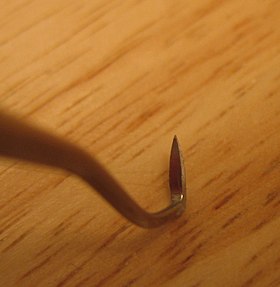This article needs additional citations for verification. (January 2014) |
| Scaling and root planing | |
|---|---|
 Close-up image of a hand scaler | |
| ICD-9-CM | 96.54 |
| MeSH | D012534 |
Scaling and root planing, also known as conventional periodontal therapy, non-surgical periodontal therapy or deep cleaning, is a procedure involving removal of dental plaque and calculus (scaling or debridement) and then smoothing, or planing, of the (exposed) surfaces of the roots, removing cementum or dentine that is impregnated with calculus, toxins, or microorganisms,[1] the agents that cause inflammation.[2] It is a part of non-surgical periodontal therapy. This helps to establish a periodontium that is in remission of periodontal disease. Periodontal scalers and periodontal curettes are some of the tools involved.
A regular, non-deep teeth cleaning includes tooth scaling, tooth polishing, and debridement if too much tartar has accumulated, but does not include root planing.
- ^ Lamont, Thomas; Worthington, Helen V.; Clarkson, Janet E.; Beirne, Paul V. (2018-12-27). "Routine scale and polish for periodontal health in adults". The Cochrane Database of Systematic Reviews. 12 (12): CD004625. doi:10.1002/14651858.CD004625.pub5. ISSN 1469-493X. PMC 6516960. PMID 30590875.
- ^ Grant, DS, Stern IB Periodontics, 6th Edition, CV Mosby and Co. St. Louis 1988.